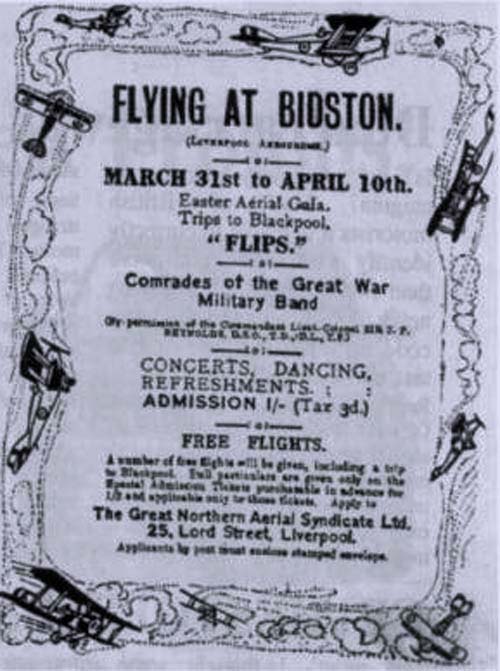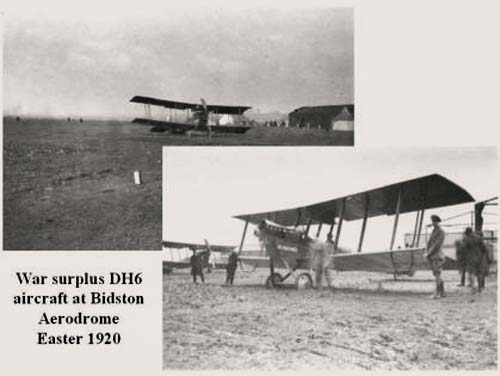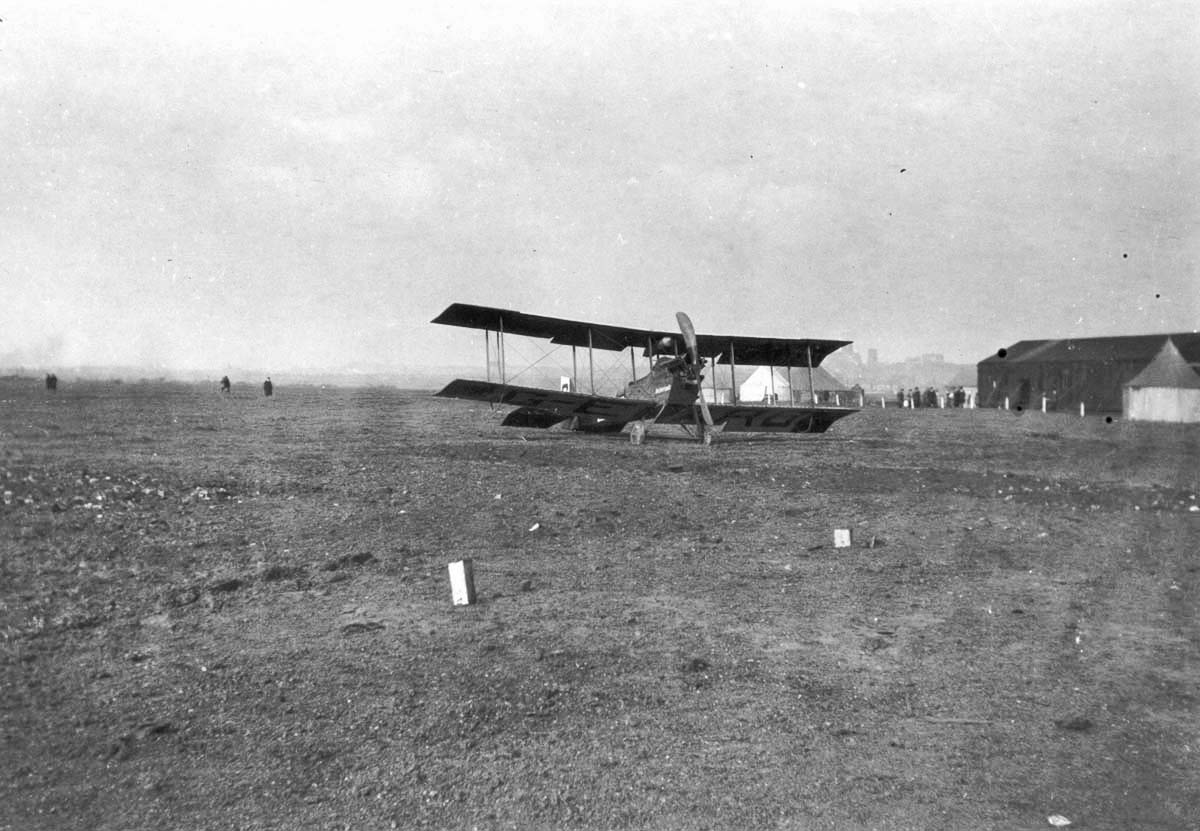Bidston Aerodrome
From an article sent by Wirral Historian Colin Schroeder, Greasby, Wirral
 |
Easter 1920 – Bidston
Aerodrome opened Great Northern Aerial Company of Liverpool acquired 35 acres of land near Bidston railway station in September 1919, for an aerodrome to be used as headquarters for their proposed services linking numerous cities around the country to “health & leisure” resorts. During the 1920 Easter holiday, between Wednesday 31st March and Saturday 10th April, they organised an Aerial Gala, to mark the opening of the aerodrome, it would then close until Whitson, then reopen and continue throughout the summer. Admission to the Gala was 1/- (5p), with a three-penny tax. Unfortunately they had not managed to put the finishing touches to the aerodrome before it was opened, three hangars had almost been completed. It was intended that the field would become permanent, and eventual be properly levelled, and made dry. Great things were being promised with the establishment of the aerodrome. Flights to London, departing Bidston at 8.45am and arriving at the London aerodrome of Cricklewood at 10.45am, this would allow “almost a full day of business”. The return journey it was suggested could be made on the same day. This service was to link up with the London to Paris flight. This started from Cricklewood at 11.30am and cost about £15. Enquires had been received from various interested parties. One Liverpool business man, wanted to booked four trips each week to London at £15 15s a journey, and a prominent medical man enquired as to the possibility of undertaking long trips at short notice for urgent consultations or operations. For the Gala, it was intended to get about twenty aircraft to the aerodrome, but the weather interfered with the arrival of a number of aircraft from Blackpool and London. The weather not only restricted flights but also decreased the attendance. How popular the Gala might have been, is shown by the fact that on the Good Friday when the weather cleared up, 800 people paid for admission and 51 passengers were carried for short trips. A full programme had been planned including “long flights”, with Blackpool as a favoured destination at five guineas (£5.25) single and seven guineas (£7.35) return. Guinea (£1.05) flights over the River Mersey would be available, and for those not minded to venture so far a field, the thrills and sensation of flight would be provided by short “flips”. There were also free flights to holders of lucky numbered admission tickets purchased in advanced. Flying was of course the chief attraction, but to give the aerodrome the character of a pleasure haunt, there were refreshments, dancing and music by the military band of the Comrades of the Great War, all held in a large pavilion which had been erected. |
| Opening Ceremony At the opening ceremony, Mr. J.J. Beasley, the chairman of the Great Northern Aerial Company, said that the company was trying to create popular interest in flying, and had established a number of aerodromes throughout the country. They were conscious of the tremendous sacrifice, which the flying man had made for their country during the Great War. He sincerely hoped that the Government would back up the efforts of the civilian flying companies. He than asked the Mayor of Birkenhead, Alderman J.H. McGaul to open the aerodrome. Alderman McGaul wished the company every success and having expressed his, admiration for the airman went on to say. “I feel that for certain purposes considering the great unrest and turmoil throughout the country, that aviation is going to be our salvation. If we can come to a place of this description when transport has been stopped between here, London, and Paris (There had been a good deal of industrial unrest with a recent rail strike). If wires have been cut, and means of communication are at the mercy of agitators who care not for the good of their country but only for themselves. If we can come to loyal citizens at a place like this and book a passage for a certain place, flying will have done a wonderful service on behalf of the rest of the Empire”. He welcomed the construction of the aerodrome, because of it proximity to the borough over which he presided and said he was sorry that their friends in Wallasey had prevented them from including the aerodrome grounds in Birkenhead’s expansion scheme. He went on to say that “The Government was perhaps not behaving as well as it might towards aviation, and it behoved those interested to create such a feeling in the whole country that the value of aviation would become apparent to every man in the street. If they did that, they would be doing a great service, not only to aviation, but also to the nation. They would be doing something for England as well as for themselves”. |
 |
 A better version of the above image |
Mr J.S. Bumphrey of the International
Aviation Company in responding to a toast to the pilots described the
obstacles placed by the Air Ministry in the way of civilians who wished
to purchase aircraft. He had set out to purchase one with his naval
gratuity. It took him six weeks to buy it and three months to obtain
delivery. The Air Ministry had refused to loan an aircraft to an aero
club, but he had seen 500 machines being broken up at Aintree. Following
the speeches, William Nichole attempted a flight, but days of continuous
rain, and a very heavy thunderstorm on the previous night, had made the
ground so sodden, that, although the aircraft could have taken off, it
was considered advisable, not to risk the possibility of a bad landing.
Conditions did improve the next day to allow flying to commence. On
Thursday, Major H.S. Shields MC. of the Golden Eagle Aviation Co. Ltd.
flew over from Blackpool in a Bristol aircraft. Major Shields had been
award the Military Cross (MC) for bringing down the first Germany two
seat Albatross aircraft behind British lines. He was twice mentioned in
dispatches and promoted to field rank in 1917 at the age of 21. He
commanded a squadron, which obtained 23 awards for gallantry. Since
leaving the Royal Air Force in August 1919, he had carried over 3,000
passengers in ex military De Havilland aircraft modified for carrying
passengers. On the Saturday, mist prevented any flying until 4.30pm when Lance Rimmer, took up two passengers, a lady and gentleman who had motored up from Chester. The longest flight of the afternoon was one taken by an ex-officer who having a badly damaged foot, hobbled to the aircraft on crutches. Lance Rimmer took him for a “spin” over Wallasey and West Kirby, the passenger voting it “A top hole stunt”. |
| The pilots came from the International Aviation Company and were all ex
officers from the Royal Air Force, were they had been instructors and had
amassed over 1,100 hours of flying. They were G.S. Hughes, William Nichole,
Norman Giroux, and Lance Rimmer Norman Giroux later operated pleasure flights
from the beach at
Southport as Giro
Aviation and Lance Rimmer a local from Meols, would figure continuously in
aviation activities around The Wirral. Two of the aircraft used were ex-military Airco DH6, G-EARA (ex-military serial C5527) and G-EARD (ex-military serial C7768). |
Bidston aerodrome, which was overlooked by Bidston Hill, covered an area of
some thirty-five acres of grassland lying between Bidston railway station and
the sand hills, a spot completely free from telegraph wires, trees, and other
obstacles. It was within two minutes walk from the railway station, and was only
a short distance from
Hoylake Road, which was served by buses
of Birkenhead Corporation Transport, who had promised to transport the public
to the aerodrome. There are no records of the aerodrome reopening at Whit. The Bidston site would be considered for possible use during the Second World War as a site for aircraft off loaded in Birkenhead docks from ships that had transported them across the Atlantic from the USA. |